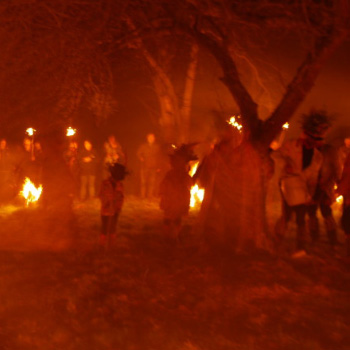As we head back to work this week, full to the brim with a week of Christmas turkey and New Year’s excess, the cold, stark realisation that the merriment is over hits hard. The 6th of January, we are told, is the date by which the fun must end and all our decorations must come down by, or we will incur bad luck for the rest of the year. But what is the significance of this date? Also known as Twelfth Night, the 6th January is steeped in history, mystery and tradition.
In Christianity it marks Epiphany, the feast celebrating the physical manifestation of God in Jesus Christ. To the Pagans, however, this date marks the end of Yule, the ancient Mid Winter Festival. On this day, the Lord of Misrule is arises and is all sorts of shenanigans occur. It is a time of high celebration that, at midnight, comes to an end when the world is once more restored to its previous state.
It’s in this context of endings and beginnings that the first crucial marker in the cider calendar occurs: The Wassail. The name is derived from the Anglo Saxon ‘wes hal’, meaning ‘be whole’, or as we say today, ‘good health’. And it’s to the cider orchards that good health is wished. Wassailing harks back to a time when rural communities had no knowledge of weather systems, climate patterns or fruit biennialism. Instead, their approach to ensuring a bountiful harvest in the forthcoming autumn was to appeal to the apple gods and goddesses, ward evil spirits from the orchards and attract benevolent insects and birds to the trees.
 The earliest accounts of the wassailing fruit trees come from St Albans in 1486 and Kent in 1585. But wasn’t truly until cider reaches its zenith in the 17th and 18th centuries that the Wassail starts to come to prominence. There are many interpretations of the Wassail depending upon where in the Country the event is taking place, The common denominators, however, are shotguns, fire and cider – a Health and Safety Officer’s worst nightmare! It begins with a torch-lit parade around the cider orchard with revellers crashing pots and pans to scare off insidious forces, often led by a Wassail King and Queen (think Pearly Kings and Queens but with more vegetative adornments and West Country accents).
The earliest accounts of the wassailing fruit trees come from St Albans in 1486 and Kent in 1585. But wasn’t truly until cider reaches its zenith in the 17th and 18th centuries that the Wassail starts to come to prominence. There are many interpretations of the Wassail depending upon where in the Country the event is taking place, The common denominators, however, are shotguns, fire and cider – a Health and Safety Officer’s worst nightmare! It begins with a torch-lit parade around the cider orchard with revellers crashing pots and pans to scare off insidious forces, often led by a Wassail King and Queen (think Pearly Kings and Queens but with more vegetative adornments and West Country accents).
The congregation then gather around the largest tree in the orchard, which has 12 small bonfires placed around it, to sing songs and appeal to Pomona, the apple Goddess, for a healthy harvest. The smallest boy in the crowd, known as the Tom Tit, is then hoisted up high and places cider-soaked bread into the branches of the apple tree – a signifier of good luck. And finally, just to make sure that they have been fully banished, shotguns are fired to rid these lands of malevolent forces. Finally, a bowl of cider is passed around from person to person, with ‘wassail’ being proffered and ‘drinkhail’ offered in return; quite literally ‘good health’ and ‘cheers’!
And this is what the Wassail is all about – an opportunity for the community to come together, to give thanks, to share and celebrate these traditions that are such a key identity of the landscapes and cultures of cider making regions. In these fast-paced times, it’s great to slow down a bit with a night out in the orchards, singing the songs of generations before and harking back to simpler times. Although the cider is probably tastier these days!
So if you go down to the orchard today, you’re sure of a big surprise….unless of course you’re celebrating the pre-Gregorian Calendar, in which case Twelfth Night isn’t for another week!
Wassail!

